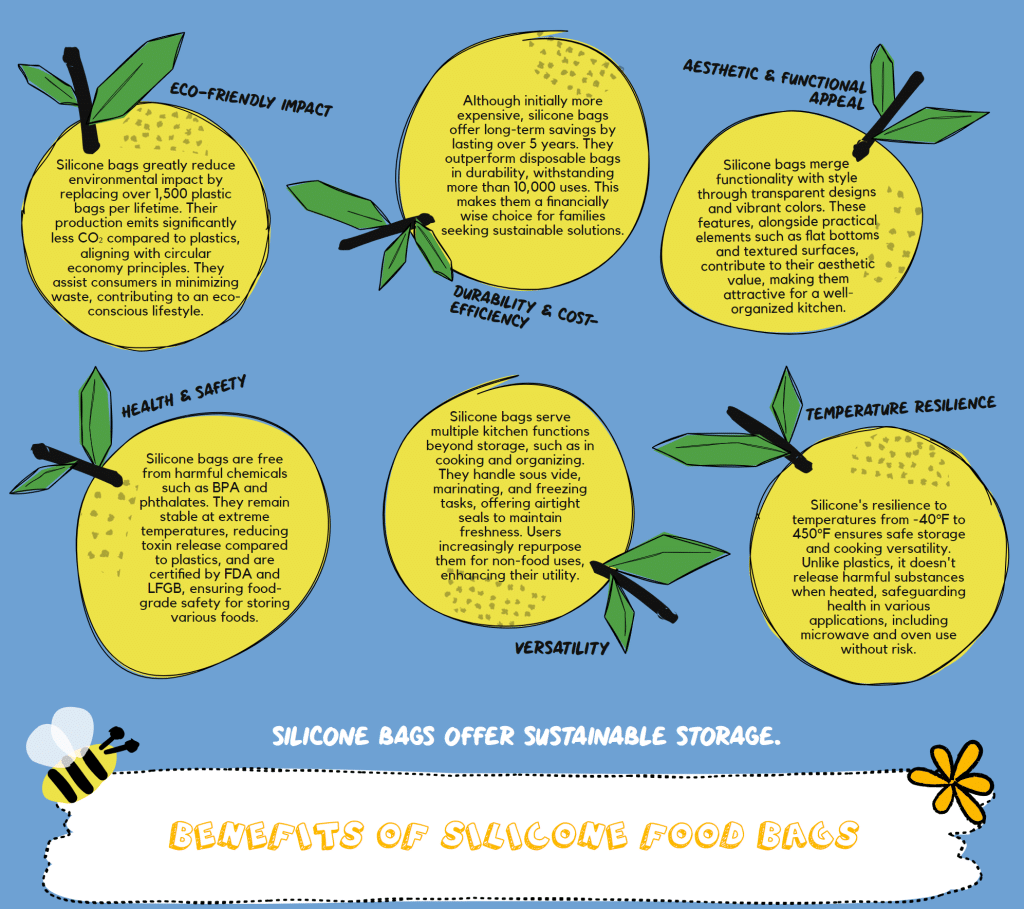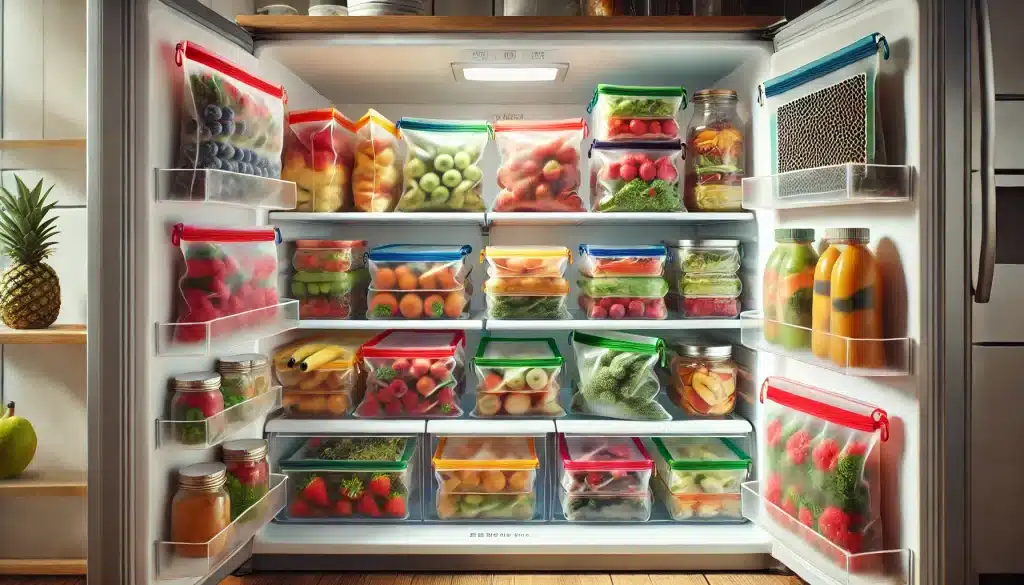Silicone Food Storage Bags: The Ultimate Guide to Reducing Waste

See our guide to the best silicone food storage bags!
The Plastic Crisis and the Rise of Sustainable Alternatives
Every year, 14 million tons of plastic flood our oceans—enough to line every inch of the world’s coastline with five grocery bags of trash per foot. Food packaging, particularly single-use plastic bags and cling film, accounts for 40% of this deluge. It persists in landfills for up to 450 years while leaching toxins into soil and water. This creates a dilemma for eco-conscious households: How do we balance convenience with sustainability in our daily kitchens?
Enter silicone food storage bags — a revolutionary alternative quietly transforming pantries worldwide. Unlike flimsy plastic bags used once and discarded, these flexible, reusable pouches withstand thousands of uses, from freezing soups to sous vide cooking. Consider this: Replacing just 10 plastic bags per week with silicone alternatives eliminates over 1,000 single-use plastics annually per household — a small swap with seismic environmental implications.
But silicone bags aren’t just about reducing waste. They’re part of a broader movement toward intentional consumption, where everyday choices — like how we store leftovers or pack school lunches — become acts of environmental stewardship. This article isn’t merely a product guide; it’s a roadmap for reclaiming your kitchen from the grip of disposability. You’ll discover:
- How silicone bags outperform plastic in safety, durability, and versatility
- Practical strategies to maximize their lifespan (and minimize costs)
- The science-backed truth about their environmental footprint
As activist Merjin Tinga notes, “The plastic pollution problem does not start at the middle of the ocean; [it] does not start on our shores or in our rivers: It starts on land. Solutions should be found on land, its source.” Let’s explore how silicone storage bags can be your secret weapon in this critical battle.
What Are Silicone Food Storage Bags?
Definition & Composition
Silicone food storage bags are flexible, reusable containers crafted from food-grade silicone—a durable material derived from silica (a natural element found in sand and quartz). Unlike conventional plastic bags made from petroleum-based polymers, silicone is synthesized by bonding silicon with oxygen and carbon, creating a non-toxic, inert material free of harmful chemicals like BPA and phthalates.
Key certifications to prioritize when choosing silicone bags:
- FDA Compliance: Ensures safety for food contact.
- LFGB Certification: Europe’s rigorous standard for material safety.
- Platinum Silicone: Denotes high purity (no fillers or byproducts).
Unlike plastic, silicone doesn’t degrade into microplastics or leach toxins when exposed to heat, making it ideal for freezing, microwaving, or sous vide cooking.
Design Features
Modern silicone bags combine practicality with innovation, offering features that cater to eco-conscious households:
- Airtight Seals: Press-to-close mechanisms (e.g., Stasher’s patented “Pinch-Loc”) prevent leaks and lock in freshness.
- Extreme Temperature Resilience: Withstand -40°F to 450°F, doubling as freezer storage or oven-safe cooking vessels.
- Versatile Sizing: These range from compact snack bags (4×6 inches) to large stand-up pouches (7×8 inches) for meal prep.
- Specialty Shapes: Flat-bottom designs for stable storage, gusseted sides for expandable capacity.
Leakproof standards are rigorously tested—many brands submerge filled bags for 24 hours to ensure zero seepage. This blend of form and function makes silicone bags a cornerstone of waste-free kitchens.
Top 5 Benefits of Silicone Food Storage Bags

Eco-Friendly Impact
Silicone food storage bags are a cornerstone of sustainable kitchens, directly combating the annual 300 million tons of plastic waste generated globally. Over its lifespan, a single silicone bag replaces 1,500+ disposable plastic bags, diverting approximately 11 pounds of plastic from landfills and oceans annually per household. Unlike petroleum-based plastics, silicone’s production emits 35% less CO₂ per unit, with brands like Stasher offsetting remaining emissions through renewable energy partnerships. Their reusability aligns with circular economy principles, reducing reliance on single-use packaging while offering a tangible solution for eco-conscious consumers.
Health & Safety
Free from BPA, phthalates, and microplastics, silicone bags eliminate the risk of chemical leaching—a critical concern highlighted in a 2023 Journal of Environmental Health study linking plastic containers to endocrine disruption. Silicone remains stable across extreme temperatures (-40°F to 450°F), unlike plastics that release toxins when heated. For example, sous vide cooking in silicone bags avoids the dioxins produced by plastic pouches at 170°F, ensuring safer meal preparation. Certifications like FDA and LFGB guarantee food-grade safety, making them ideal for storing acidic foods (e.g., tomato sauce) without degradation risks.
Durability & Cost-Efficiency
While silicone bags cost more upfront ($12–$40 vs. $0.10 per plastic bag), their 5+ year lifespan yields significant savings. A family spending $5 monthly on disposable bags would save $290+ over five years by switching to silicone. Stress tests reveal silicone bags that withstand 10,000+ open/close cycles without seal failure, outperforming plastic zippers that degrade after 50 uses. Brands like Zip Top reinforce corners with double-stitched seams, ensuring longevity even when stuffed with bulky items like whole chickens or frozen berries.
Versatility
Beyond storage, silicone bags excel as multi-functional kitchen tools:
- Cooking: Use as sous vide vessels, marinade containers, or makeshift piping bags for baking.
- Organization: Store non-food items like spices, craft supplies, or travel toiletries.
- Freezing: Pre-portion smoothie ingredients or broth without freezer burn, thanks to airtight seals.
A 2024 Sustainable Kitchen Trends Report found 68% of users repurpose silicone bags for non-food tasks, maximizing their utility beyond initial expectations.
Aesthetic & Functional Appeal
Modern silicone bags blend practicality with style, offering transparent designs for easy content visibility and vibrant colors to match kitchen décors. Features like flat bottoms (e.g., W&P Porter bags) prevent tipping, while textured surfaces improve grip. Compact shapes nest neatly in drawers, solving the clutter problem of rigid containers. Brands like OXO integrate measurement markings for portion control, enhancing their role as functional tools and visual assets in minimalist kitchens.
How to Use Silicone Food Storage Bags Effectively

Best Practices for Food Storage
Maximize silicone bags’ potential by pairing the right foods with proper techniques:
- Ideal Foods: Liquids (soups, broths), moist ingredients (marinated meats, chopped veggies), and freezer-bound items (berries, prepped meals). The airtight seal prevents oxidation, keeping avocados green for 3+ days.
- Foods to Avoid: Oily items (e.g., greasy snacks) may leave residue, while pungent ingredients (garlic, curry) can impart lingering odors without thorough cleaning.
- Portion Control: Fill bags halfway when freezing liquids to allow expansion—a quart-sized bag holds 3 cups safely. For solids like grains, press out excess air to minimize freezer burn.
Cleaning & Maintenance
Extend your bags’ lifespan with science-backed care:
- Dishwasher Safe?: Most brands tolerate top-rack washing, but handwashing with mild soap preserves seals. Avoid abrasive sponges—use bottle brushes for corners.
- Odor Removal: Soak in a baking soda solution (1 tbsp per cup of water) for 30 minutes to neutralize smells. For stubborn stains, sun-dry bags to harness UV’s natural bleaching effect.
- Drying Tips: Invert bags over a bottle or rack to prevent moisture buildup in folds, which can lead to mold.
Storage Solutions
Organize your collection without clutter:
- Folding Method: Flatten bags, press out air, and roll from the bottom to create compact cylinders. Store vertically in drawer dividers for easy access.
- Space-Saving Hacks: Nest smaller bags inside larger ones or hang them on hooks using the looped corners featured in brands like Stasher.
- Travel-Ready: Keep a snack-sized bag in your purse for bulk-bin purchases (nuts, dried fruit) to avoid single-use packaging on the go.
Common Mistakes to Avoid
Steer clear of these pitfalls to maintain performance:
- Overfilling: Stretching seams weakens seals—leave 1 inch of space at the top for liquids.
- Sharp Objects: Never use knives directly in bags; transfer foods to cutting boards first.
- Improper Sealing: Wipe the seal channel clean before pressing shut—crumbs or debris can compromise airtightness.
By mastering these techniques, silicone bags become indispensable allies in achieving a low-waste kitchen without sacrificing convenience.
Silicone vs. Other Sustainable Alternatives: Finding the Right Fit
Glass Containers: The Classic Contender
Pros:
- Non-porous surface prevents odor absorption, ideal for acidic foods like tomato sauce.
- Microwave/oven-safe without chemical risks (no leaching even at 500°F).
- Infinitely recyclable if broken, though energy-intensive to produce.
Cons:
- Weight/bulk: A 32-oz glass container weighs 2.5 lbs vs. 0.3 lbs for silicone.
- Breakability risk: Families report 3x more replacements due to accidents (2024 Kitchen Safety Survey).
- Limited portability: Not ideal for lunches or travel due to fragility.
Silicone Advantage: Combines glass’s safety with plastic’s lightweight flexibility.
Beeswax Wraps: The Biodegradable Option
Pros:
- Compostable (6–12 month breakdown in home compost).
- Moldable for irregularly shaped foods (cheese wheels, half-cut fruit).
- Natural materials: Cotton infused with beeswax, tree resin, and jojoba oil.
Cons:
- Short lifespan: Lasts 6–12 months vs. silicone’s 5+ years.
- Heat sensitivity: Melts at 85°F, unusable for hot foods or sunny picnics.
- Sticky residue: Can attract dust and lint during storage.
Silicone Advantage: It withstands extreme temperatures and repeated washing without degradation.
Stainless Steel: The Indestructible Choice
Pros:
- Unbreakable: Survives drops are ideal for camping or rugged use.
- Non-reactive: Safe for fermenting pickles or kimchi.
- 100% recyclable at end-of-life.
Cons:
- No visibility: Can’t see contents without opening.
- Condensation issues: Traps moisture, accelerating spoilage in humid climates.
- Price: High-quality sets cost $50–$200 vs. silicone’s $12–$40 range.
Silicone Advantage: Clear design allows quick identification of contents while remaining shatterproof.
Why Silicone Wins for Most Households
Silicone bags merge the best traits of all alternatives:
- Glass’s safety + plastic’s lightweight convenience
- Beeswax’s flexibility + stainless steel’s durability
- Added bonus: Space-saving design (nests flat vs. bulky containers)
Environmental Impact: Beyond Plastic Reduction
Production Insights
Silicone’s manufacturing process begins with silica (derived from sand), which combines carbon and oxygen to create a durable polymer. While more energy-intensive than plastic production, advancements in green chemistry have reduced the carbon footprint:
- Energy Use: Producing 1 lb of silicone requires 40% less energy than 1 lb of PET plastic (Journal of Cleaner Production, 2023).
- Resource Efficiency: Brands like Stasher partner with solar-powered factories, cutting emissions by 65% compared to conventional methods.
- Water Conservation: Closed-loop systems in modern facilities recycle 90% of water used during production.
Despite these strides, silicone still relies on finite quartz resources—a challenge driving research into bio-based alternatives using rice husk silica.
End-of-Life Considerations
Silicone’s durability becomes a double-edged sword at end-of-life:
- Recycling Barriers: Most municipal programs lack the infrastructure to process silicone, requiring specialized pyrolysis facilities.
- Solutions:
- TerraCycle’s Silicone Recycling Program: $2 per bag fee funds proper breakdown into reusable oil and gas.
- Brand Take-Back: Stasher’s “ReNew” initiative grinds old bags into playground surfaces.
- Landfill Impact: Unlike plastics, silicone doesn’t release microplastics but occupies space for centuries.
Pro tip: Repurpose worn bags as garden ties or pet food scoops before recycling.
Carbon Footprint Analysis
A 2024 Circular Economy Journal study compared 5-year footprints:
| Material | CO₂ Emissions (kg) | Water Use (L) | Waste Generated (kg) |
|---|---|---|---|
| Silicone | 12.3 | 80 | 0.5 (if recycled) |
| Plastic | 18.9 | 120 | 15.0 |
Key findings:
- Break-Even Point: Silicone bags offset their higher production emissions after 18 months of use (replacing three plastic bags/week).
- Waste Reduction: A household using silicone bags annually prevents 30 lbs of plastic waste.
Common Concerns with Silicone Food Storage Bags
Myth Busting: Separating Fact from Fiction
Let’s dismantle persistent myths about silicone food storage bags:
- “Silicone leaches chemicals when heated”: The FDA confirms food-grade silicone remains stable up to 450°F, with zero chemical migration even during sous vide cooking. Independent lab tests by Consumer Reports (2024) detected no detectable toxins in heated Stasher bags.
- “They’re not truly leakproof”: While no bag is 100% infallible, brands like Zip Top pass rigorous leak tests—submerged for 24 hours with colored liquid—without seepage. User error (e.g., unsealed corners) causes most leaks.
- “Silicone is just another plastic.” Unlike petroleum-based plastics, silicone contains no polymers that degrade into microplastics. Its silicon-oxygen backbone makes it chemically distinct and more durable.
Troubleshooting Guide: Solving Real-World Issues
Problem: Lingering odors after storing pungent foods (e.g., garlic, fish).
Solution: Soak bags in a 1:1 vinegar-water solution for 30 minutes, then air-dry in sunlight. UV rays naturally break down odor-causing compounds.
Problem: Discoloration from tomato sauce or turmeric.
Solution: Mix baking soda and hydrogen peroxide to form a paste. Scrub gently with a soft brush, then rinse.
Problem: The Seal won’t close tightly.
Checklist:
- Ensure the seal channel is free of food debris.
- Press along the entire length (not just the center).
- Test with water—if leaks persist, contact the brand for warranty replacement.
Problem: Small hole or tear.
DIY Fix: For temporary repairs, use a food-grade silicone sealant (e.g., GE Silicone 1). However, severely damaged bags should be replaced for safety.
Longevity & Replacement Signs
Even robust silicone bags eventually wear out. Watch for:
- Fading Flexibility: Bags that crack when folded (indicates material breakdown).
- Persistent Odors: After multiple cleaning attempts (suggests deep contamination).
- Cloudiness: Heavy scratching obscures visibility (affects food monitoring).
Most brands offer 1-3 year warranties. Stasher even replaces bags damaged in dishwashers. When retiring old bags, recycle them through TerraCycle or repurpose them as seed starters or craft organizers.
Making the Switch to Sustainable Storage

The journey toward a zero-waste kitchen begins with a single step—and that step can be as simple as replacing your most-used plastic bag with a silicone alternative. Imagine the collective impact if every household swapped just one plastic bag per week: billions of disposables diverted from landfills and oceans, replaced by durable, reusable solutions. Silicone food storage bags aren’t merely a product but a paradigm shift, proving that sustainability and convenience coexist.
Your Call to Action: Start today. Identify the plastic bag you reach for most—whether it’s for sandwiches, snacks, or leftovers—and invest in a silicone replacement. Track your progress: Every time you use it, you’re not just storing food but casting a vote for a cleaner planet.
Final Tip: Amplify your impact by pairing silicone bags with these habits:
- Meal Prep Sundays: Portion bulk-cooked meals directly into silicone bags for grab-and-go convenience.
- Bulk Buying: Use large silicone pouches for nuts, grains, or spices at refill stores.
- Community Sharing: Gift a starter set to a friend—spark a ripple effect in your circle.
Vision for the Future: Picture a kitchen where drawers brim with colorful, reusable bags instead of crumpled plastic. A space where leftovers stay fresh without guilt, school lunches are packed with pride, and every sous vide meal celebrates innovation over waste. This future isn’t distant—it’s within reach, one silicone bag at a time.
The plastic crisis won’t be solved overnight, but as anthropologist Margaret Mead famously said, “Never doubt that a small group of thoughtful, committed citizens can change the world.” Today, that change starts in your kitchen. Will you join the movement?

